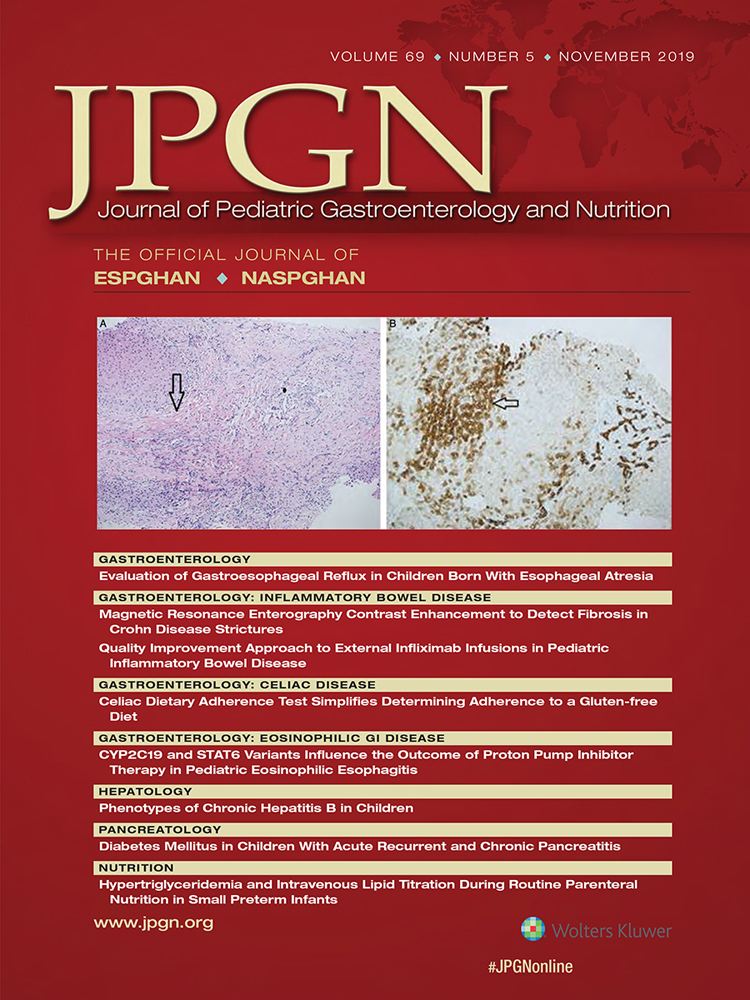Phenotypes of Chronic Hepatitis B in Children From a Large North American Cohort
Supplemental digital content is available for this article. Direct URL citations appear in the printed text, and links to the digital files are provided in the HTML text of this article on the journal's Web site (www.jpgn.org).
The Hepatitis B Research Network was funded as a series of cooperative agreements [U01s] by the National Institute of Diabetes and Digestive and Kidney Diseases [NIDDK]: U01 DK082916 [to K.S., PIs: K.M. and N.R.-B.]; U01 DK082864 [to S.B.]; U01 DK082874 [H.J.; PI: S.L.]; U01 DK082944 [to N.T.; PI: P.R.]; U01 DK082843 [to L.R.R.; PI: S.J.S.], U01 DK082871 [to A.D.B.; PI: J.T.]. Addition support was provided by an interagency agreement between NIDDK and the Centers for Disease Control and Prevention: A DK-3002-001 [to L.M.G.-R.]) and via the National Center for Advancing Translational Sciences, NIH via CTSA grants: UL1 TR000423 [to K.S.] and UL1 TR000004 [to N.T.]), and by Roche Molecular Systems via a CRADA through the NIDDK.
K.B.S. has research grants from Gilead, Bristol-Myers Squibb, Roche/Genentech and consults for Gilead, Roche/Genentech and Up to Date.
A.M.D.B. has research grants from Gilead and serves on advisory boards to Gilead and Bristol-Myers Squibb.
K.F.M. has research grants supported by Gilead, Merck, Shire, and owns stock in Merck.
P.R. has research grants from Abbvie, Gilead, Bristol-Myers Squibb, Roche/Genentech and consults for Gilead, Abbvie, Intercept, Alexion, Retrophil, Albireo, Audentes and Mirum.
S.C.L. receives research funding from Abbvie and Bristol-Myers Squibb.
Norberto Rodriguez-Baez has research grants supported by Gilead.
J.T. has research grants from Gilead, Alnylam Inc., Arrowhead Pharmaceuticals and Dicerna Inc., and consultant relationships with BioMarin, Editas, Proteostasis and Retrophin.
Y.K.C., M.L., S.J.S., and J.H.H. have no duality or conflicts of interest.
ABSTRACT
Objective:
The aim of the study was to define chronic HBV phenotypes in a large, cohort of United States and Canadian children utilizing recently published population-based upper limit of normal alanine aminotransferase levels (ULN ALT), compared with local laboratory ULN; identify relationships with host and viral factors.
Background:
Chronic hepatitis B virus (HBV) infection has been characterized by phases or phenotypes, possibly associated with prognosis and indications for therapy.
Methods:
Baseline enrollment data of children in the Hepatitis B Research Network were examined. Phenotype definitions were inactive carrier: HBeAg-negative with low HBV DNA and normal ALT levels; immune-tolerant: HBeAg-positive with high HBV DNA but normal ALT levels; or chronic hepatitis B: HBeAg-positive or -negative with high HBV DNA and abnormal ALT levels.
Results:
Three hundred seventy-one participants were analyzed of whom 274 were HBeAg-positive (74%). Younger participants were more likely be HBeAg-positive with higher HBV DNA levels. If local laboratory ULN ALT levels were used, 35% were assigned the immune tolerant phenotype, but if updated ULN were applied, only 12% could be so defined, and the remaining 82% would be considered to have chronic hepatitis B. Among HBeAg-negative participants, only 21 (22%) were defined as inactive carriers and 14 (14%) as HBeAg-negative chronic hepatitis B; the majority (61%) had abnormal ALT and low levels of HBV DNA, thus having an indeterminant phenotype. Increasing age was associated with smaller proportions of HBeAg-positive infection.
Conclusions:
Among children with chronic HBV infection living in North America, the immune tolerant phenotype is uncommon and HBeAg positivity decreases with age.




